Chintan Girish Modi
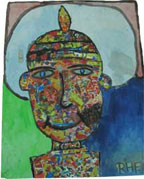 What might Kabir, a 15th century saint-poet, have to offer present day schools? This question has been central to the Kabir Project’s recent explorations in the field of education. As part of our ongoing work with schools and interactions with educators, we have mapped out some broad areas to explore further and build on the developing insights. Instead of making a package for instant delivery to schools, the emphasis is on building relationships with them and coming up with ideas suited to the needs, context and culture of each school. The resources we draw on include the poetry of Kabir, the musical renditions of it by various folk and classical singers, the Kabir films made by Shabnam Virmani, children’s books, and anything else that we can lay our hands on. There is a strong intention to collaborate with other organizations and initiatives dedicated to peace, nonviolence and harmony.
What might Kabir, a 15th century saint-poet, have to offer present day schools? This question has been central to the Kabir Project’s recent explorations in the field of education. As part of our ongoing work with schools and interactions with educators, we have mapped out some broad areas to explore further and build on the developing insights. Instead of making a package for instant delivery to schools, the emphasis is on building relationships with them and coming up with ideas suited to the needs, context and culture of each school. The resources we draw on include the poetry of Kabir, the musical renditions of it by various folk and classical singers, the Kabir films made by Shabnam Virmani, children’s books, and anything else that we can lay our hands on. There is a strong intention to collaborate with other organizations and initiatives dedicated to peace, nonviolence and harmony.
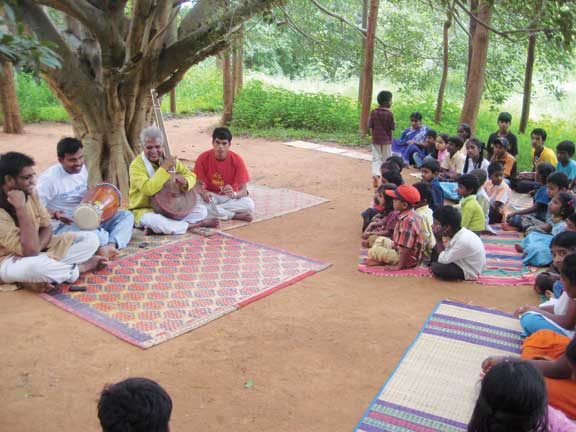
Kabir and Diversity
While Kabir’s poetry grew out of his response to the concerns of his time, it continues to speak to us in the present day. The critical spirit of his words is a refreshing change from empty gestures of solidarity that come in the guise of proclamations about all human beings being part of one large family. Hindu Muslim Sikh Isai, Hum Sab Hai Bhai Bhai is something we often hear as part of national integration speeches, but how often do we initiate conversations about these differences in school? How can we embrace when we are not prepared to engage with ‘different-ness’? An appreciation of a shared humanity that binds us all can come only from interrogating what led to these divisions in the first place. This brings us to exploring the territory of labels, stereotypes, selfhood, othering, caste, religion, and so on. Our aim is to encourage children to examine the nature of conflict, its causes and how it can be overcome. And this seems especially important in a world where polarities are rigidly marked and identities are quickly consolidated, on the basis of something as fleeting as thought and opinion. We recently showed Shabnam Virmani’s film Had-Anhad to students at Shishuvan school in Mumbai, where it opened up discussion about popular perceptions and stereotypes regarding Pakistan, and the source of these – newspapers, films, and parents. Listing out the images that Pakistan conjured up in their minds was easy, but it took them a while to interrogate where these images came from.
Our discussions of diversity also extend to Kabir himself. There is not one single Kabir, but many Kabirs. He has been appropriated in sacred and secular spaces. His poetry is sung in folk and classical idioms. Visual representations of him vary widely. There are many different versions of stories surrounding his birth, life and death. However, this multi-faceted reality does not feature in the textbooks that children read, where the life story of Kabir is framed in a fixed, rigid way. Students do not get a taste of the multiplicity of Kabirs that flow around them. At a recent workshop with Rajghat Besant School in Varanasi, a student remarked, “I had just heard that Kabir was born to Muslim parents and brought up by a Brahmin widow. After watching Had-Anhad, I have been exposed to such varied perceptions – Muslim, Dalit, and Hindu.” Students may get thrown off by competing versions of reality because they are usually served only one version as the truth. However, it is vital that we expose them to the idea that history is not fixed and final, but always framed by the persons narrating it. And that reality is a complex thing, it is not black and white or clear-cut.
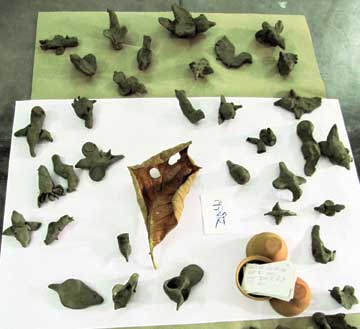 Kabir and Ecology
Kabir and Ecology
While environmental education has become a buzzword in schools, it is approached mostly through the lens of science. The assumption is that of human beings and nature as separate entities in conflict with each other because of competing priorities. We want to infuse this space with the energy of mystical poetry and folk traditions that enable us to see the place of human beings in a deeper, connected ecosystem. What sparked off this idea was the story of a brave little parrot dousing a raging forest fire, which we encountered in a Kabir bhajan sung in Rajasthan. This song strikes an instant chord with students and teachers. It inspired students of Shibumi school in Bangalore to come up with some beautiful paintings and even a theatrical interpretation of the story. Research around that story led us to various versions told in cultures around the world.
As we began to develop the idea of Kabir and ecology, it occurred to us how much of the wisdom that flows through his poems is drawn from the environment around him. Images of nature abound in his poetry, and he exhorts us to see the relationship between inner and outer ecologies. The mess that we have made of our surroundings is perhaps a reflection of the mess that lies inside of us. And we perhaps don’t care enough for the environment because we see it as separate from us. The poetry of Kabir and other mystics also urges us to question values like acquisitiveness and competition that have become such an integral part of our lives that we have lost the ability to see how our actions impact our inner and outer worlds. Vishakha Chanchani, artist and illustrator who is currently working with the Kabir Project, facilitated a Kabir and Ecology workshop for middle school students at Rajghat Besant School in Varanasi this September. The strength of her methodology lay in that she led the children to explore these ideas not only through discussion but also through hands-on work with paint, clay, thread, water, found objects, and other materials.
 Bringing Kabir alive through music
Bringing Kabir alive through music
The Hindi classroom has traditionally been the space in which most students encounter the poetry of Kabir. This space can be redeemed from the drudgery of how poetry gets taught in our schools – where poems get looked at as artifacts produced by some creative genius, meant to be memorized by low mortals who can barely get at the meaning through a simplistic paraphrase. We want teachers and students to appreciate the fact that poetry is not frozen in textbooks but often quite rooted in people’s everyday lives.
Engagement with poetry need not be a complicated literary task. The joy is in discovering how poems speak to us in our own situations. Our attempt is to introduce students to the rich folk singing traditions that bring alive the power of Kabir’s poetry in languages like Malwi, Kutchi and Marwari often subsumed under the label of ‘Hindi’ , yet different from the language of their textbooks. There is a different quality to the engagement and enjoyment that is possible through an exposure to the folk music traditions of India that have carried this poetry to us over five centuries. We work with various singers – Prahlad Tipanya (Malwa, Madhya Pradesh), Kaluram Bamaniya (Malwa, Madhya Pradesh), Moora Lala Marwada (Kutch), Mahesha Ram (Rajasthan), and Mukhtiyar Ali (Rajasthan) – to bring the poetry of Kabir alive through musical performances in various folk and semi classical styles.
Several schools have invited them for special assemblies and concerts. Not only is this an opportunity to interact with singers but also to learn songs and delve into their meanings in ways that textbook teaching does not allow for. Sometimes, the music teacher teaches students a Kabir song or two beforehand so that they can sing along with the singer. When poetry becomes music, boundaries start getting erased. Students and teachers often sing along or break into spontaneous dance. Musicians also invite children to the stage to come and sing with them.
Teachers have also creatively used the opportunity of live performance in other ways. For instance, at Mallya Aditi International School in Bangalore, there were classroom discussions with students about identity, religion, caste and plurality prior to a live concert of Prahlad Tipanya in their school. We heard of sixth-grader Shiv Patil’s response to this from his mother Bela. Shiv was moved by the songs and their translations. He loved the idea that God resides in all of us, and that the religious labels we wear do not matter. The night after the performance, when his (Jain) family was reciting prayers, Shiv refused to utter the line ‘Jainam Jayati Shasanam’. He told his mother that the idea of one religion being the best and ruling the world does not sit well with him, and that they should not sing it henceforth.
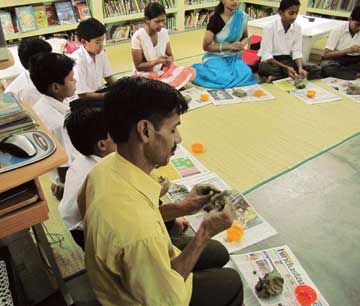 Workshops for teachers
Workshops for teachers
We have done a few ‘Learning with Kabir’ workshops with artists, youth activists, educators and community workers. These have been residential immersion programmes designed to get participants to engage with the poetry, music and ideas. We have found that this is often a rich personal growth space for participants. In the case of teachers, an inspirational space of this kind would be significant if they are to share Kabir with students in a deeply felt and meaningful way.
We have received a few invitations to facilitate a component on Kabir as part of teacher training/development programmes. Perhaps the importance of this is being felt with the new spate of research on teacher beliefs and attitudes – knowing that teachers are not simply subject experts, but individuals with their own ideas and frames of reference depending on their socio-cultural backgrounds and life outside school. A general exposure to Kabir is then something we imagine to be a trigger point for teachers for self-examination in their own lives and to think about ideas regarding life, death, impermanence, peace, nonviolence, living with differences and such. We hope this awareness would extend into thinking about their own roles as teachers and mediators of ideas, and the other roles they are expected to fill, their clashing priorities, their own practices as teachers, their attitudes towards children belonging to communities other than their own, etc.
Rural support programme in Malwa
The Kabir Project has built close friendships with folk singers in the Malwa region of Madhya Pradesh. This has now translated organically into a rural support programme intended to inject fresh energy and enthusiasm into oral folk traditions through community-led initiatives and outreach work with schools. We are partnering with folk singers Narayan Singh Delmia and Kaluram Bamaniya for indepth and frequent engagement with two schools in Dewas district, and this process is being supported locally by the NGO Eklavya. The learning of songs and playing of instruments would be accompanied by workshops using creative methodologies that would engage the children in a non-pedantic, lively manner. The children’s mandalis would be given the opportunity to interact with senior folk musicians from Malwa and outside, and also to present their own music at village programmes and other forums.
About the project
The Kabir project brings together the experiences of a series of ongoing journeys in quest of this 15th century North Indian mystic poet in our contemporary worlds. Started in 2003, these journeys inquire into the spiritual and socio-political resonances of Kabir’s poetry through songs, images and conversations.
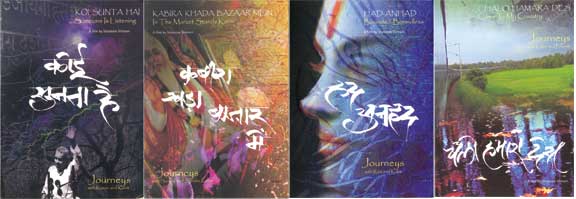
We journey through a stunning diversity of social, religious and musical traditions which Kabir inhabits, exploring how his poetry intersects with ideas of cultural identity, secularism, nationalism, religion, death, impermanence, folk and oral knowledge systems. The core inspiration of the project is music, and Kabir comes alive in 4 documentary films, 10 audio CDs and poetry books through the power of song. The four films are titled Had-Anhad, Koi Sunta Hai, Chalo Hamara Des, and Kabira Khada Bazaar Mein.
This is a 6-year initiative undertaken by filmmaker Shabnam Virmani as an artist-in-residency project at the Srishti School of Art, Design and Technology in Bangalore, India. The project is supported by the Ford Foundation, New Delhi.
Apart from the films, CDs and books, the true spirit of the Kabir Project lies in the taana-baana (warp & weft) of social networks and friendships built over these years between the singers, scholars, activists, artists, illustrators, students, music lovers and lay persons who have been woven together through student labs, festivals, workshops and other exchanges. Folk singers Prahlad Tipanya, Mukhtiyar Ali and others have become deep friends, giving the project its soul force. Our advisors include scholars Linda Hess and Purushottam Agrawal, poet Ashok Vajpeyi, and singer Vidya Rao.
The project is growing rapidly in many ways, with cultural groups, educational, social and community-based institutions and individuals taking the initiative to organize workshops and interactive events that include the films, folk singers, live music concerts and discussions.
In the next phase of the project, work has begun towards constructing a multi-media web-space to browse the music, poetry and ideas of Kabir. This web-space will be co-created with the involvement of folk singers, along with innovative social experiments to vitalize the Kabir oral traditions at the village level. Exploratory workshops and school-based interactions have begun to explore ways in which the power of Kabir’s poetry can be brought alive in education.
The author runs People in Education, an online group that connects a diverse bunch of people committed to education, and provides a forum for sharing of resources and experiences. He can be reached at chintangirishmodi@gmail.com.
